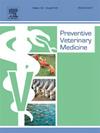全球绵羊和山羊中十二指肠贾第虫的患病率和危险因素:系统回顾和荟萃分析
IF 2.4
2区 农林科学
Q1 VETERINARY SCIENCES
引用次数: 0
摘要
十二指肠贾第虫是一种重要的肠道寄生虫,可导致全球人类和动物腹泻。本研究旨在评估十二指肠螺旋体在世界范围内的分布,确定其在绵羊和山羊中的流行程度,并确定与感染相关的危险因素。利用国际数据库收集相关研究,进行了全面的系统评价。采用随机效应荟萃分析来估计十二指肠螺杆菌的全球患病率。截至2025年1月,共有来自32个国家的104项研究符合纳入标准。十二指肠棘球绦虫在小型反刍动物中的全球总体流行率为14 %(95 % CI: 11 %-17 %)。值得注意的是,发病率最高的是位于纬度- 60°至60°之间的温带和热带地区(18.9 %;95 % CI: 14.7 %-24.0 %),在南北半球纬度45°以上的地区(21.3 %;95 % ci: 13.4 %-32.2 %)。季节分析显示,患病率高峰发生在冬季(16.1 %;95 % ci: 9.4 %-26.0 %)。地中海气候以冬湿夏干为特征,其患病率明显较高(40.5 %;95 % CI: 19.6 %-65.5 %),特别是在集约化养羊的地区。此外,年龄被认为是一个重要的危险因素,羔羊(≤1岁)的患病率更高(17.3 %;95 % CI: 13.5 %-22.4 %)与成年小反刍动物(7.0 %;95 % ci: 4.8 %-10.1 %)。在成年人群中,母羊的患病率略有升高。时间分析显示,2010年至2019年期间患病率显著下降(7.7 %;95 % ci: 5.4 %-10.9 %;P = 0.0097),其次是2020年后的复苏。总体而言,尽管观察到随着时间的推移呈下降趋势(斜率= - 0.0282),但这种下降在统计上并不显著(p = 0.1549)。这些发现强调了实施有针对性的区域控制和管理战略的必要性,特别是在集约化耕作和人畜共患风险增加的地区,以减轻十二指肠螺杆菌的传播和影响。本文章由计算机程序翻译,如有差异,请以英文原文为准。
Prevalence and risk factors of Giardia duodenalis in sheep and goats in global: A systematic review and meta-analysis
Giardia duodenalis is a significant intestinal parasite responsible for causing diarrhea in humans and animals globally. This study aimed to evaluate the worldwide distribution of G. duodenalis, as well as to determine its prevalence and identify risk factors associated with infections in sheep and goats. A comprehensive systematic review was performed utilizing international databases to collect relevant studies. A random-effects meta-analysis was applied to estimate the global prevalence of G. duodenalis. A total of 104 studies from 32 countries, published up to January 2025, fulfilled the inclusion criteria. The overall global prevalence of G. duodenalis in small ruminants was found to be 14 % (95 % CI: 11 %-17 %). Notably, the highest prevalence were recorded in temperate and tropical regions situated between latitudes −60° to 60° (18.9 %; 95 % CI: 14.7 %-24.0 %), and in areas above 45° latitude in both northern and southern hemispheres (21.3 %; 95 % CI: 13.4 %-32.2 %). Seasonal analysis revealed peak prevalence occurring during winter months (16.1 %; 95 % CI: 9.4 %-26.0 %). Mediterranean climates, characterized by wet winters and dry summers, demonstrated notably higher prevalence (40.5 %; 95 % CI: 19.6 %-65.5 %), particularly in regions with intensive sheep farming practices. Furthermore, age was identified as a significant risk factor, with lambs (≤1 year) exhibiting higher prevalence (17.3 %; 95 % CI: 13.5 %-22.4 %) compared to adult small ruminants (7.0 %; 95 % CI: 4.8 %-10.1 %). Within adult populations, ewes displayed slightly elevated prevalence. Temporal analysis indicated a significant decline in prevalence between 2010 and 2019 (7.7 %; 95 % CI: 5.4 %-10.9 %; p = 0.0097), followed by a resurgence after 2020. Overall, despite an observed downward trend over time (slope = −0.0282), this decline was not statistically significant (p = 0.1549). These findings underscore the necessity for implementing targeted, region-specific control and management strategies, particularly in regions with intensive farming practices and increased zoonotic potential, to mitigate the spread and impact of G. duodenalis.
求助全文
通过发布文献求助,成功后即可免费获取论文全文。
去求助
来源期刊

Preventive veterinary medicine
农林科学-兽医学
CiteScore
5.60
自引率
7.70%
发文量
184
审稿时长
3 months
期刊介绍:
Preventive Veterinary Medicine is one of the leading international resources for scientific reports on animal health programs and preventive veterinary medicine. The journal follows the guidelines for standardizing and strengthening the reporting of biomedical research which are available from the CONSORT, MOOSE, PRISMA, REFLECT, STARD, and STROBE statements. The journal focuses on:
Epidemiology of health events relevant to domestic and wild animals;
Economic impacts of epidemic and endemic animal and zoonotic diseases;
Latest methods and approaches in veterinary epidemiology;
Disease and infection control or eradication measures;
The "One Health" concept and the relationships between veterinary medicine, human health, animal-production systems, and the environment;
Development of new techniques in surveillance systems and diagnosis;
Evaluation and control of diseases in animal populations.
 求助内容:
求助内容: 应助结果提醒方式:
应助结果提醒方式:


